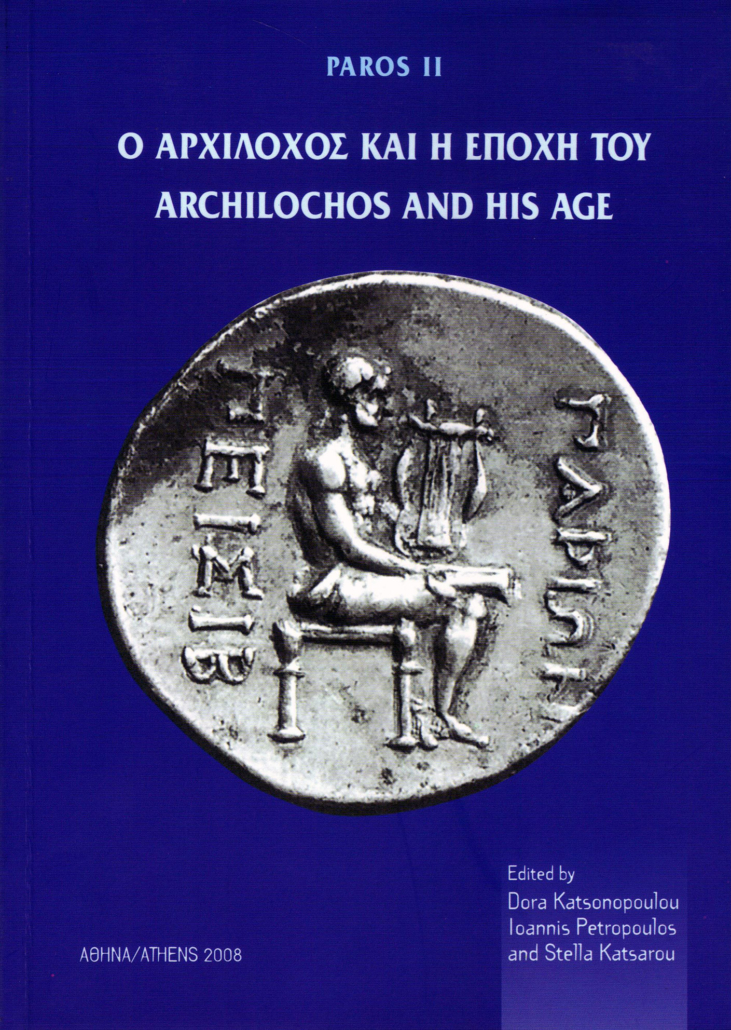PAROS II
Archilochos and his Age
The volume Paros II is the second Proceedings volume in a series of International Conferences concerning Paros and the Cyclades organized by the IAPC and held in Paroikia of Paros. The volume entitled Archilochos and his Age includes the papers presented at the Second International Conference on the Archaeology of Paros and the Cyclades organized by the PCIA in collaboration with the Municipality of Paros and the Cultural Society “Archilochos” of Paros and held in Paroikia of Paros from 7-9 October 2005. The specific aims of the Conference were to present and discuss (a) Archilochos’ personality and works and (b) the results of the most recent archaeological investigations in the major area of Paros, the Cyclades and the Parian colony of Thasos with reference to the age of Archilochos.
The Conference on Archilochos followed the First International Conference dedicated to the Parian marble and held in Paroikia from 2-5 October 1997. The Proceedings of this Conference, entitled PARIA LITHOS – Parian Quarries, Marble and Workshops of Sculpture, edited by Demetrius U. Schilardi & Dora Katsonopoulou, were published in 2000. The present volume (Paros II), published by the IAPC and edited by Dora Katsonopoulou, Ioannis Petropoulos & Stella Katsarou, includes 30 scholarly papers listed under two entities. Part I, entitled Archilochos. His Personality and Works, contains 16 papers discussing the poetry and personality of Archilochos. Part II, entitled The Age of Archilochos. Monuments and Artistic Representations, includes 14 papers on the history and archaeology of Paros, Thasos and the Cyclades in Archilochos’ time.
In Part I, Archilochos’ reputation in ancient sources as poet and personality is investigated (Gerber) and an attempt is made to understand his biographical myth by examining the Delphic oracles about the poet and his life (Portulas). A number of scholars are concerned with the iambic side of Archilochos. In this connection, the ritual and secular aspects of iambos are discussed to suggest that Archilochean iambos is a secular genre and in particular a sympotic one (Kantzios). The relations between oath and perjury are explored in the light of Archilochos Fr. 172 (Hawkins) whereas the nature of Greek iambos is discussed and a new suggestion is offered on the meaning of Archilochos Fr. 215W (Rotstein). A new interpretation of the relationship between praise and blame poetry is attempted (Riu) as well as a reading of Archilochos’ poet-persona from the view point of his iambic function (Lavigne). Another group of scholars devote their articles to interpretation of the erotic poetry of Archilochos with the aim of understanding the poet as lover (Strauss-Clay) or attempting to interpret famous poems such as the Cologne Epode by comparison to ancient local cults and/or medieval and modern Greek folk-songs (Petropoulos). On the basis of the content of some of Archilochos’ epodes, it is claimed that Archilochos used his poetry to turn against his enemies in politics or private life (Bowie). The poems of Archilochos related to war and the warrior’s life are also examined with the purpose of understanding Archilochos as warrior- poet (Lavelle). Archilochos’ role in Thasos with regard to the colonization of Thasos by the Parians is read anew in the light of part of the Sosthenes Inscription (Tsantsanoglou) and new suggestions on interpretation of certain poems of Archilochos are offered (Fr. 2W, Boegehold and Fr. 35W, Correa). Finally, common elements in the poetry of Archilochos and the modern Greek poet Odysseas Elytis are explored (Georgoussis) as well as the reception of Archilochos and his poetry in contemporary Greece (Zervou).
In Part II, Archilochos’ age and monuments connected to his cult on Paros are discussed on the basis of literary, inscriptional and archaeological evidence from Paros itself, the Parian colony on Thasos, the Cycladic islands and the area of Ephesos in Asia Minor. First, an overview of the political economy of Paros in the age of Archilochos is offered and the role of the poet in this economy is investigated (Tandy). Archilochos’ cult on his native island, which was established in the late 6th century BC and lasted till the 3rd century AD, is discussed on the basis of Parian iconography (Clay) and interpretation of the Mnesiepes Inscription (Nagy). In the specific context of portraits of poets related to cult practices, Archilochos’ portraiture is presented (Corso). The new elegy of Archilochos on the Arkadian hero Telephos lately discovered at Oxford, is presented and interpreted for the first time in the light of literary evidence and representations in architectural sculpture (Katsonopoulou). The restoration of monuments related to Archilochos on Paros (Ohnesorg) and of the Totenmahl relief (Partida) is proposed based on new suggestions. Recent pottery finds from Paroikia depicting battle and farming scenes are examined in order to investigate interrelations and influences between poetry and painting (Zapheiropoulou). Ceramic productions of Paros and Naxos are discussed with the purpose of detecting possible influences between the two islands (Simantoni-Bournia). Within the sphere of the Cycladic world in Archilochos’ time, the recent archaeological finds from the island of Despotikon near Antiparos are set forth and discussed (Kouragios). The colonization of Thasos by the Parians in Archilochos’ time is also illustrated with the support of archaeological data from the recent excavations on Thasos (Blondé et al.) and ceramic evidence from the colony (Coulié). Finally, Ephesos in Asia Minor at the time of Archilochos is discussed from the perspective of architecture and philosophy (Bammer) and with regard to the cult of Ephesian Artemis (Muss).

